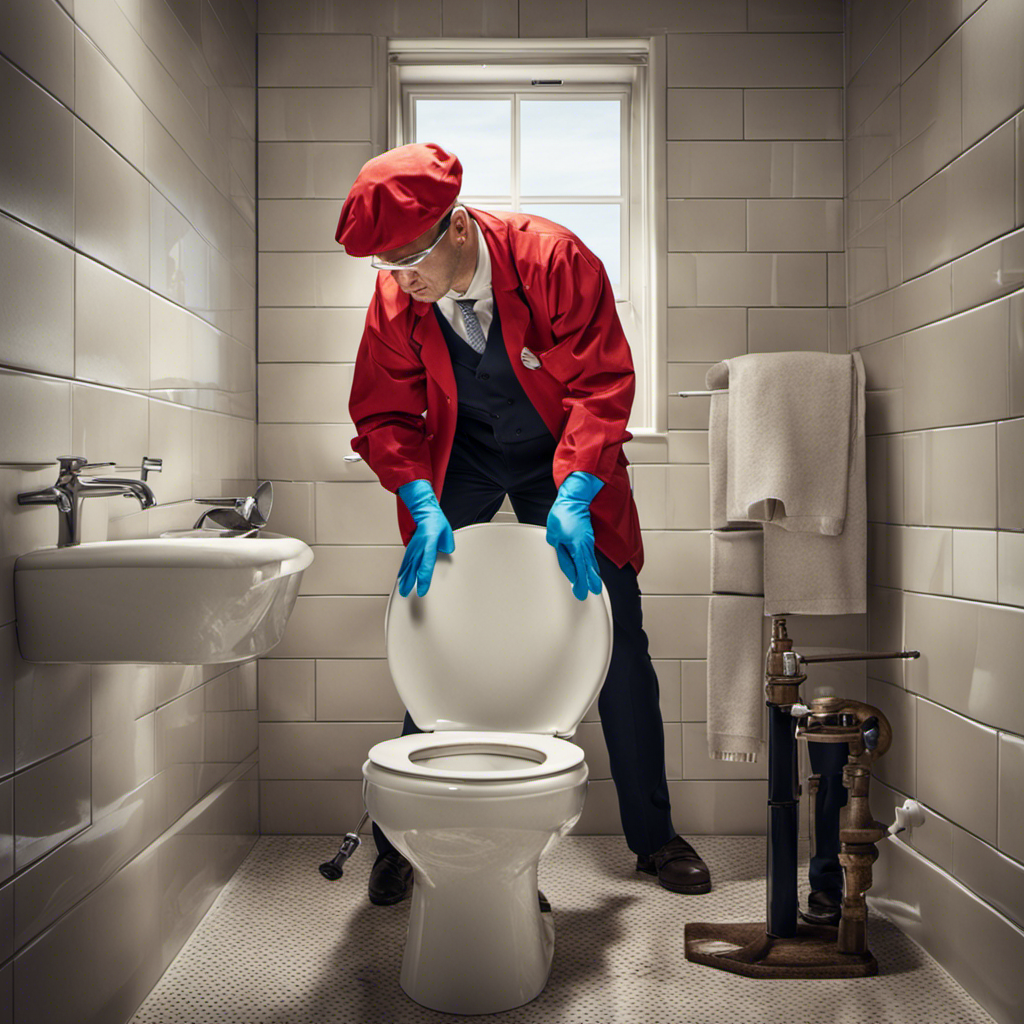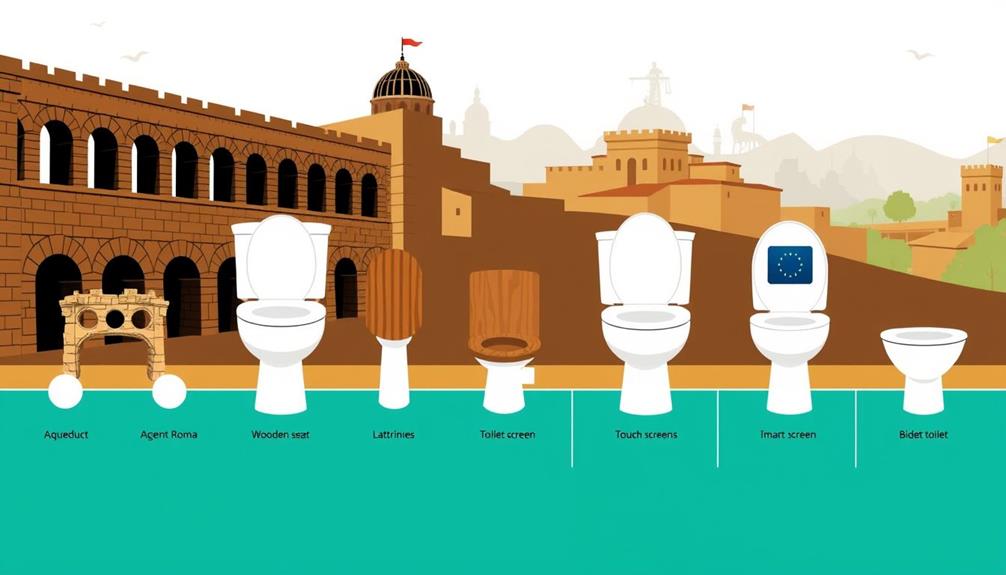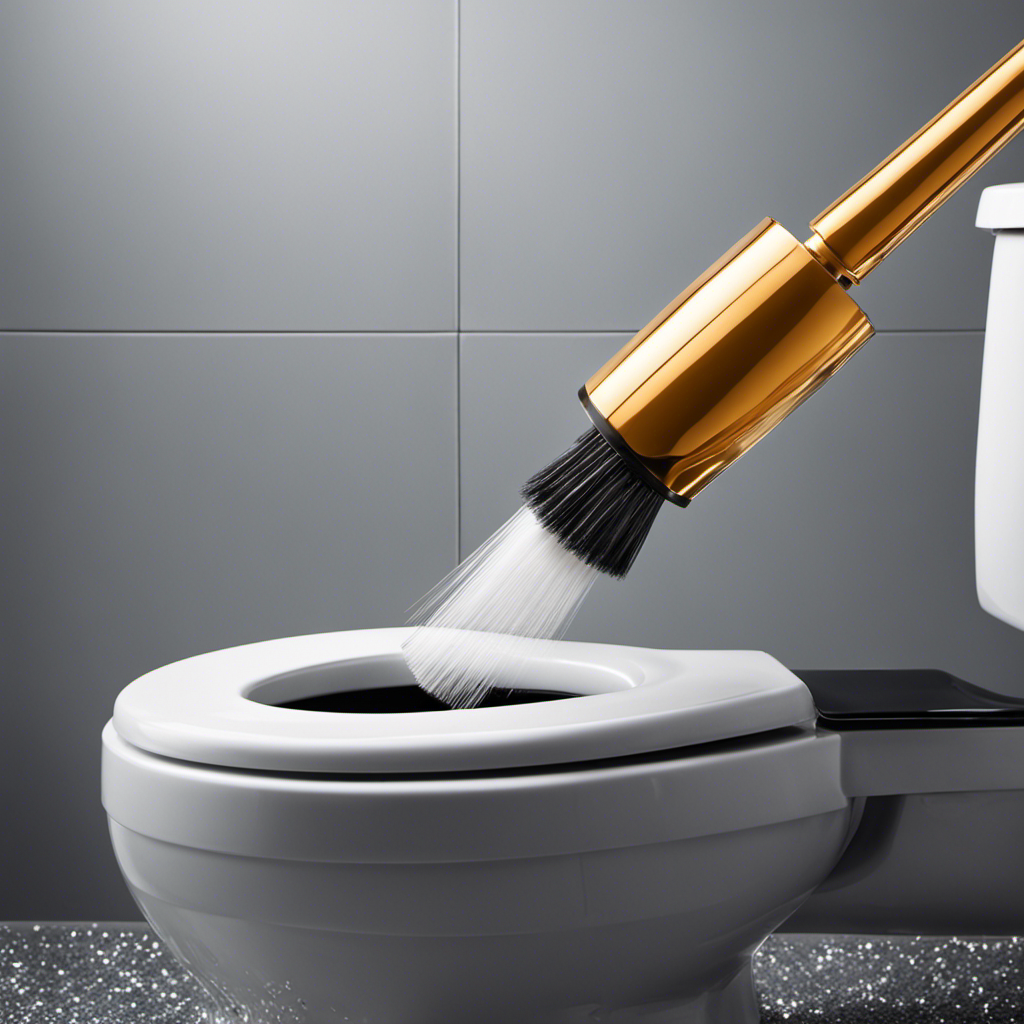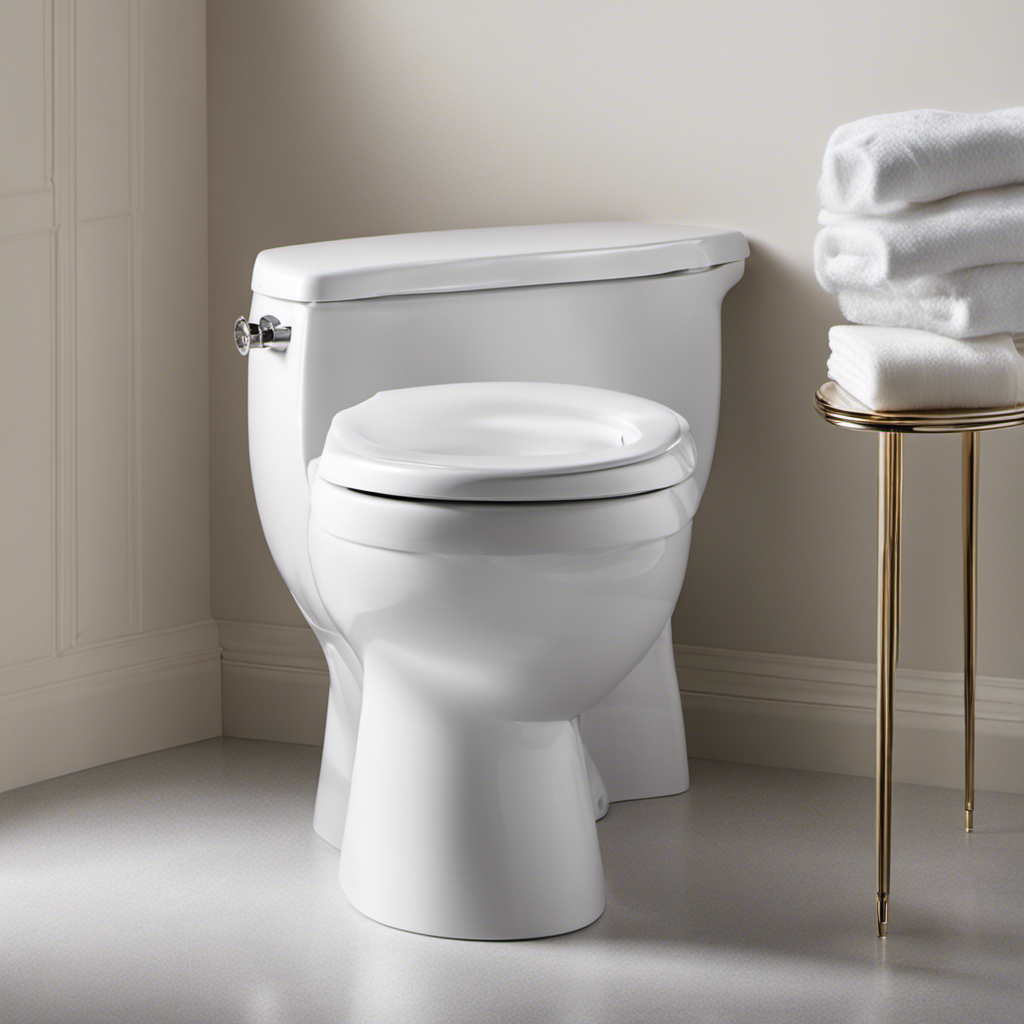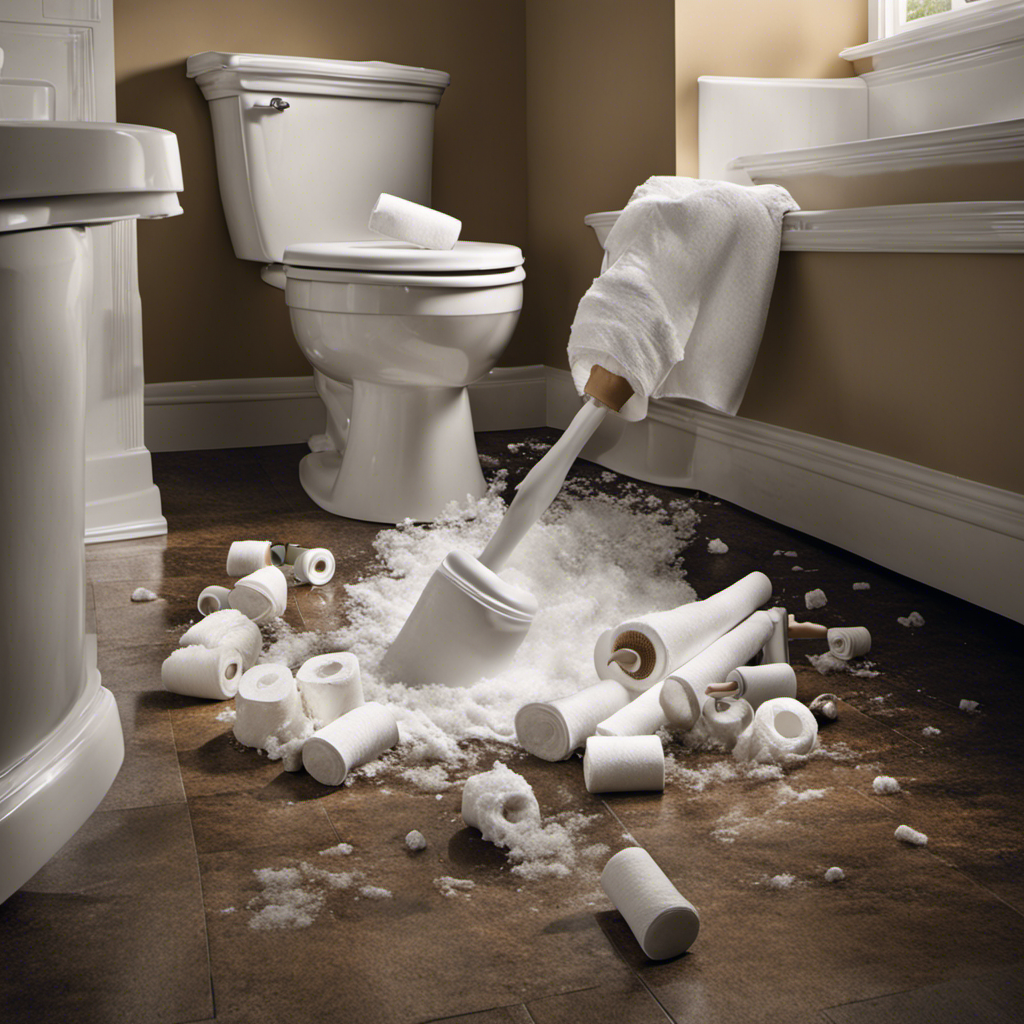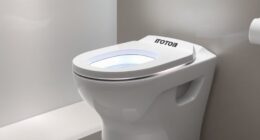Hey there! Ever had the frustrating experience of a clogged toilet? Well, fear not, because I’ve got the ultimate guide on how to unclog that stubborn beast.
Trust me, I’ve been there, and I know just the steps to take to get your toilet back in working order. From assessing the severity of the clog to using natural remedies and exploring chemical options as a last resort, I’ve got you covered every step of the way.
So let’s dive in and banish those clogs for good!
Key Takeaways
- Determine the severity of the clog before taking action
- Understand common causes of toilet clogs, such as excessive toilet paper usage and foreign objects being flushed
- Use a plunger to create a tight seal and plunge vigorously to unclog the toilet
- Consider alternative methods like regularly cleaning drains with vinegar and baking soda, and using a drain snake to physically remove the clog
Assess the Severity of the Clog
You’ll want to start by determining how severe the clog is. Assessing the clog severity will help you decide on the appropriate course of action.
There are a few signs that can indicate a severe clog. Firstly, if the water level in the toilet bowl is rising and doesn’t go down after multiple flushes, it’s a clear indication of a significant blockage.
Another sign is if you notice water backing up into other drains in your home, such as the bathtub or sink. This suggests that the clog is affecting the main drain line.
Lastly, if you hear gurgling or bubbling noises coming from the toilet when you flush, it means that the clog is causing air to get trapped in the pipes.
These signs point to a severe clog, and it’s important to take immediate action to resolve the issue.
Gather Necessary Tools and Materials
When it comes to unclogging a toilet, it’s important to have a good understanding of the techniques and common causes of clogs.
First, familiarize yourself with the various unclogging techniques, such as using a plunger or a toilet auger. These tools can effectively remove blockages and restore proper flow.
Second, identify the common causes of toilet clogs, which can include excessive toilet paper usage, foreign objects being flushed, or even tree roots infiltrating the plumbing system.
Toilet Unclogging Techniques
Toilet clogs can often be resolved using a plunger. However, before attempting any unclogging techniques, it is important to take some precautions. First, ensure that the water supply to the toilet is turned off to prevent any overflow. Next, protect the surrounding area by laying down towels or plastic sheets. Now, let’s move on to some DIY toilet unclogging tips.
- Start by positioning the plunger over the drain hole, making sure it creates a tight seal.
- Begin plunging vigorously, using an up-and-down motion. This will create pressure and dislodge the clog.
- Repeat the plunging motion several times, being careful not to break the seal.
- After a few attempts, remove the plunger and flush the toilet to check if the clog is cleared.
- If the clog persists, consider using a toilet auger or calling a professional plumber.
Remember to always use caution when attempting to unclog a toilet and never use excessive force.
Common Toilet Clog Causes
One common cause for clogs in the bathroom is excessive toilet paper usage. When we use too much toilet paper, it can easily get stuck in the pipes and cause a blockage. To prevent toilet clogs and avoid the hassle of dealing with a clogged toilet, it’s important to be mindful of our toilet paper usage.
Here are some signs of a clogged toilet to look out for:
-
Slow draining: If you notice that the water is taking longer than usual to drain after flushing, it could be a sign of a clog.
-
Gurgling sounds: Strange noises coming from the toilet when you flush or drain the sink can indicate a clog in the pipes.
-
Water backup: If water starts to rise up in the toilet bowl after flushing, it’s a clear indication of a clog.
-
Foul odor: A persistent foul smell coming from the toilet can be a sign that there’s a blockage causing waste to accumulate.
Use a Plunger to Attempt to Remove the Clog
You can use a plunger to try and remove the clog. Plunger techniques are effective for unclogging toilets and can help troubleshoot common plumbing issues. Here’s a step-by-step guide on how to use a plunger properly:
-
Start by ensuring that the plunger has a good seal with the toilet bowl. Place it over the drain hole, making sure it covers it completely.
-
Push the plunger down gently to expel any air trapped inside. This creates suction, which is essential for dislodging the clog.
-
Begin plunging vigorously up and down, maintaining a good seal with the toilet bowl. The force generated helps break up the clog and push it through the pipes.
-
Continue plunging for about 15-20 seconds, then check if the water starts to drain. If it does, congratulations! You’ve successfully unclogged the toilet.
-
If the clog persists, repeat the process a few more times, or try using a toilet auger for stubborn clogs.
Try a Toilet Auger for Stubborn Clogs
When it comes to stubborn clogs that just won’t budge, using a toilet auger can be an effective solution.
A toilet auger, also known as a closet auger, is a specialized tool designed to clear clogs in toilets.
It features a long, flexible cable with a corkscrew-like end that can break through and remove even the most stubborn obstructions.
While a plunger is often the go-to tool for unclogging toilets, it’s worth exploring alternative methods such as a toilet auger for those particularly stubborn clogs.
Effective Toilet Auger
To effectively unclog your toilet, try using a toilet auger. A toilet auger, also known as a closet auger, is a tool specifically designed to tackle stubborn clogs in toilets. Here are some key points to consider when using a toilet auger:
-
Pros and cons of using a toilet auger:
- Pros: Effective at breaking up tough clogs, easy to use, affordable.
- Cons: May scratch porcelain if not used carefully, requires some physical effort.
-
How to choose the right toilet auger for your needs:
- Consider the length of the auger: Longer augers are better for deep clogs.
- Look for a durable, high-quality auger with a flexible cable.
- Check if the auger has a protective sleeve to prevent scratching.
Alternative Unclogging Methods?
If you’re looking for alternative ways to clear stubborn clogs, consider trying some of these methods. Clog prevention tips and eco-friendly unclogging methods can save you time, money, and headaches.
First, let’s talk about prevention. Regularly cleaning your drains with a mixture of vinegar and baking soda can keep clogs at bay. Avoid flushing anything other than toilet paper down the toilet, as this can lead to blockages.
Now, if you already have a clog, try using a plunger. Make sure to create a tight seal and apply firm pressure to dislodge the blockage. Another option is using a drain snake to physically remove the clog.
Implement Natural Remedies to Unclog the Toilet
You can easily unclog the toilet by using natural remedies like baking soda and vinegar. These DIY solutions are not only effective but also environmentally friendly.
Here’s a step-by-step guide on how to implement natural remedies to unclog your toilet:
- Start by pouring one cup of baking soda into the toilet bowl.
- Follow it up with two cups of vinegar.
- Let the mixture sit in the bowl for about 30 minutes to allow the chemical reaction to take place.
- Finally, flush the toilet and observe if the clog has been cleared.
Explore Chemical Options as a Last Resort
Using harsh chemicals should be a last resort when attempting to clear a persistent clog in the toilet. While they can be effective, they also pose risks to both your health and the environment. If you do decide to use chemicals, it is important to prioritize chemical safety. Always wear protective gloves and goggles to avoid direct contact with the chemicals. Additionally, make sure to carefully follow the instructions provided by the manufacturer.
Be aware of the environmental impact of these chemicals as well. They can contaminate water sources and harm aquatic life. Therefore, it is crucial to consider other options first, such as natural remedies or using a plunger.
Transitioning into the next section, proper toilet maintenance is key to preventing future clogs.
Prevent Future Clogs With Proper Toilet Maintenance
Proper toilet maintenance is essential for avoiding future clogs and ensuring smooth flushing. To prevent clogs effectively, follow these toilet maintenance tips:
-
Regularly clean the toilet bowl: Use a toilet brush and a non-abrasive cleaner to remove any build-up of grime or mineral deposits. This helps prevent blockages and keeps your toilet functioning properly.
-
Watch what you flush: Only flush toilet paper and human waste down the toilet. Avoid flushing items like wet wipes, feminine hygiene products, or cotton balls, as they can easily cause clogs.
-
Check the water level: Make sure the water level in the tank is at the recommended mark. If it’s too high or too low, adjust the float valve accordingly. This helps maintain optimal flushing power.
-
Conduct periodic inspections: Inspect the toilet’s internal components, such as the flapper valve and flush handle, for any signs of wear or damage. Replace any faulty parts to prevent potential clogs.
Conclusion
In conclusion, unclogging a toilet may seem like a daunting task, but with the right tools and techniques, it can be easily resolved.
By following the step-by-step process outlined in this article, you can confidently tackle any clog that comes your way.
Remember, prevention is key, so make sure to maintain your toilet properly to avoid future clogs.
With a little know-how and some elbow grease, you’ll have your toilet back in working order in no time.
So go forth and conquer those clogs like a seasoned plumber!
